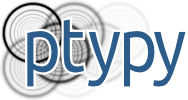Welcome Ptychonaut!¶
PtyPy 1 is a framework for scientific ptychography compiled by P.Thibault, B. Enders, and others (see AUTHORS).
It is the result of years of experience in the field of ptychography condensed into a versatile python package. The package covers the whole path of ptychographic analysis after the actual experiment is completed - from data management to reconstruction to visualization.
The main idea of ptypy is: “Flexibility and Scalabality through abstraction”.
Most often, you will find a class for every concept of ptychography in
PtyPy. Using these or other more abstract base classes, new ideas
may be developed in a rapid manner without the cumbersome overhead of
data management
, memory access or distributed computing. Additionally, PtyPy
provides a rich set of utilities and helper functions,
especially for input/output
Get started quickly here or with one of the examples in the templates directory.
Highlights¶
Difference Map 4 algorithm engine with power bound constraint 5.
Maximum Likelihood 3 engine with preconditioners and regularizers.
A few more engines (RAAR, sDR, ePIE, …).
Fully parallelized using the Massage Passing Interface (MPI). Simply execute your script with:
$ mpiexec/mpirun -n [nodes] python <your_ptypy_script>.py
GPU acceleration based on custom kernels, CuPy or PyCUDA/reikna. See examples in
templates/accelerate,templates/engines/cupyandtemplates/engines/pycuda.A client-server approach for visualization and control based on ZeroMQ . The reconstruction may run on a remote hpc cluster while your desktop computer displays the reconstruction progress.
Mixed-state reconstructions of probe and object 2 for overcoming partial coherence or related phenomena.
On-the-fly reconstructions (while data is being acquired) using the the
PtyScanclass in the linking mode linking mode
Quicklinks¶
- The complete documentation.
- Starting from a clean slate?Check out the installation instructions
- You want to understand the inner principles of ptypy without having to browse the source code?Have a look at the tutorials about its special classes.
Footnotes
- 1
B.Enders and P.Thibault, Proc. R. Soc. A 472, 20160640 (2016), doi
- 2
P.Thibault and A.Menzel, Nature 494, 68 (2013), doi
- 3
P.Thibault and M.Guizar-Sicairos, New J. of Phys. 14, 6 (2012), doi
- 4
P.Thibault, M.Dierolf et al., Ultramicroscopy 109, 4 (2009), doi
- 5
K.Giewekemeyer et al., PNAS 108, 2 (2007), suppl. material, doi

